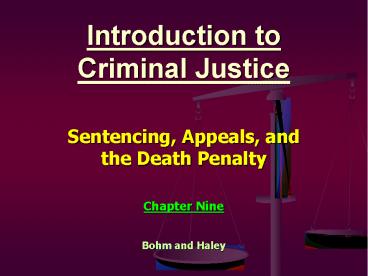Introduction to Criminal Justice - PowerPoint PPT Presentation
Title:
Introduction to Criminal Justice
Description:
Introduction to Criminal Justice Sentencing, Appeals, and the Death Penalty Chapter Nine Bohm and Haley Sentencing If a criminal defendant pleads guilty or is found ... – PowerPoint PPT presentation
Number of Views:330
Avg rating:3.0/5.0
Title: Introduction to Criminal Justice
1
Introduction to Criminal Justice
- Sentencing, Appeals, and the Death Penalty
- Chapter Nine
- Bohm and Haley
2
Sentencing
- If a criminal defendant pleads guilty
- or is found guilty by a judge or jury,
- then the judge (or sometimes a jury)
- must impose a sentence.
3
Judicial Limitations
- Judges cannot impose just any sentence,
- they are limited by
- Statutory provisions
- Prevailing philosophical rationales
- Organizational considerations
- Presentence investigation reports
- Their own personal characteristics
4
Statutory Provisions
- State and federal legislative bodies enact penal
codes that specify appropriate punishments for
each statutory offense, or class of offense. - Types of punishment in the U.S. include
- Fines
- Probation
- Intermediate punishments more restrictive than
probation but less restrictive and costly than
imprisonment. - Imprisonment
- Death
5
Types of Sentence
- Indeterminate Sentencing
- A sentence with a fixed minimum and maximum term
of incarceration, rather than a set period.
- Determinate Sentencing
- A sentence with a fixed period of incarceration,
which eliminates the decision-making
responsibility of parole boards. - Three basic types
- Flat-time
- Mandatory
- Presumptive
6
Philosophical Rationales
- The goals of criminal sanctions
- or criminal punishment are
- the prevention and control of crime.
- The philosophical rationales are
- Retribution
- Incapacitation
- Deterrence
- Rehabilitation
- Restoration
7
Retribution
- A justification for punishment
- that implies repayment for
- an offense committed.
- Revenge eye for an eye
- or
- Just Desserts they deserve it
8
Incapacitation
- The removal or restriction
- of the freedom of those found
- to have violated criminal laws.
9
Deterrence
- General Deterrence
- The prevention of people in general
- from engaging in crime
- by punishing specific individuals
- and making examples of them.
- Special or Specific Deterrence
- The prevention of individuals from
- committing crimes again by punishing them.
10
Rehabilitation
- The attempt to correct the personality
- and behavior of convicted offenders
- through educational, vocational, or therapeutic
treatment and to return - them to society as law-abiding citizens.
11
Restoration and Victims Rights
- Restoration places equal emphasis on victims
rights and needs, and the successful
reintegration - of offenders into the community.
- Restitution and community service
- are commonly used.
12
Organizational Considerations
- A judges sentence is guided by
- organizational considerations
- Plea bargains
- Prison overcrowding
- Cost of the sentence vs. the benefits derived
from it.
13
Presentence Investigation Reports(PSIs or PSIRs)
- Reports (background checks) that are prepared by
- probation officers and used in the
- federal system and the majority of states to
- help judges determine the appropriate sentence.
- Also, they are used in classifying probationers,
parolees, and prisoners according to their
treatment needs and security risks.
14
Personal Characteristics of Judges
- Socioeconomic backgrounds
- Law school attended
- Prior court experience
- The number of offenders defended earlier in their
career
- Biases concerning various crimes
- Emotional reactions and prejudices toward the
defendants - Their own personalities
- Marital and sexual relations
15
Appeals
- Defendants can appeal their convictions on legal
or constitutional grounds. - Because the defendant has already been found
guilty, the presumption of innocence no longer
applies during the appellate process, and the
burden of showing why the conviction should be
overturned shifts to the defendant.
16
The Death Penalty
- A punishment for offenders convicted
- of capital or aggravated murder.
- Methods of execution in the U.S.
- Lethal injection
- Electrocution
- Lethal gas
- Hanging
- Firing squad
17
Supreme Court Decisions
- Furman vs. Georgia
- (1972)
- Gregg vs. Georgia
- (1976)
18
Procedural Reforms in Gregg
- Bifurcated trials
- Guidelines for judges and juries aggravating and
mitigating factors. - Automatic appellate review
- A two-stage trial consisting of a guilt phase
and a separate penalty phase. If a defendant is
found guilty in the guilt phase, then at the
penalty phase, the judge or jury must determine
whether the sentence will be death or life in
prison.
19
Automatic Appellate Review
- Currently, 37 of the 38 states with
- death penalty statutes provide for
- automatic appellate review
- of all death sentences,
- regardless of the defendants wishes.































